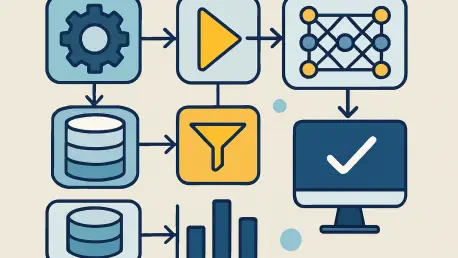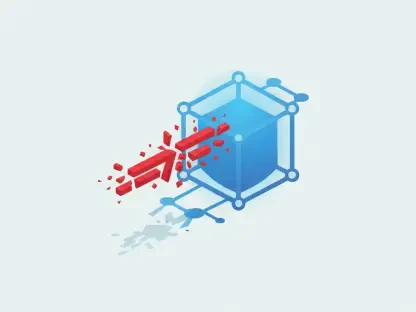In an era where data drives decision-making across industries, the ability to construct robust and scalable data pipelines has become a cornerstone of effective analytics and machine learning workflows. Imagine a retail company grappling with massive daily sales data, needing to clean, transform, and model it for accurate forecasting, all while ensuring quality and reproducibility. This scenario underscores the growing demand for tools like Dagster, an open-source data orchestration platform that simplifies the creation of end-to-end pipelines. This article explores a detailed, hands-on approach to building such pipelines, integrating raw data processing with machine learning capabilities. By focusing on practical implementation, the content delves into setting up custom storage solutions, partitioning data, and embedding validation and modeling steps. This guide aims to equip readers with actionable insights into creating reproducible workflows that can handle real-world complexities with ease.
1. Setting Up the Foundation for Data Pipelines
The journey to building an effective data pipeline begins with laying a solid foundation through the installation of essential tools and libraries. Dagster, a powerful orchestration framework, requires integration with libraries like Pandas for data manipulation and scikit-learn for machine learning tasks. Installing these in a collaborative environment ensures that all necessary dependencies are readily available for pipeline development. Beyond installation, importing core modules such as NumPy for numerical operations and Pandas for data handling is a critical step. Additionally, defining a base directory, such as /content/dagstore, alongside a specific start date for data partitioning, helps organize outputs systematically. This setup not only streamlines the subsequent steps of data processing but also ensures that the pipeline remains structured and accessible for future scaling or modifications, catering to dynamic data needs.
Once the initial setup is complete, attention shifts to establishing a clear framework for data storage and organization. A well-defined base directory serves as the repository for all pipeline outputs, ensuring that data artifacts are stored in a consistent location. Setting a start date for partitioning—such as the first of a chosen month—allows for daily data segmentation, which is vital for handling large datasets over time. This early configuration facilitates seamless integration of assets and resources within Dagster, enabling smooth transitions between data ingestion, transformation, and modeling phases. By prioritizing these foundational elements, the pipeline gains the flexibility to adapt to varying data volumes and complexities. This approach also minimizes potential bottlenecks during execution, paving the way for efficient data handling and processing in later stages of development.
2. Configuring Custom Storage with IOManager
A pivotal aspect of crafting a data pipeline in Dagster involves designing a custom storage solution to manage asset persistence effectively. Developing a tailored CSVIOManager allows for the saving of outputs as CSV or JSON files, depending on the data type, while also enabling easy retrieval during pipeline execution. This custom manager handles DataFrame objects by writing them to CSV format and other metadata to JSON, logging each operation for transparency. Registering this manager as csv_io_manager within Dagster ensures that all assets utilize a consistent storage mechanism. This configuration is essential for maintaining data integrity across different pipeline stages, allowing for smooth transitions between raw data input and processed outputs without loss of information or structure.
Beyond the creation and registration of the CSVIOManager, implementing a daily partitioning scheme adds another layer of organization to the pipeline. By defining partitions based on daily intervals starting from a specified date, data processing can be segmented into manageable chunks. This approach is particularly beneficial for handling time-series data, such as sales records, where daily granularity is crucial for analysis. Partitioning ensures that each day’s data is processed independently, reducing the risk of cross-contamination or errors spanning multiple time periods. Combined with the custom IOManager, this setup provides a robust framework for storing and accessing data artifacts systematically. Such meticulous configuration is key to building pipelines that are not only efficient but also scalable to accommodate future data growth or additional processing requirements.
3. Crafting Core Assets for Data Processing
With the foundational setup in place, the next step involves creating core assets that form the backbone of the data pipeline. The raw_sales asset is designed to generate synthetic daily sales data, incorporating noise and occasional missing values to simulate real-world inconsistencies. This asset captures the imperfections often encountered in actual datasets, providing a realistic starting point for further processing. Metadata about row counts and null values is logged alongside the data, offering visibility into its initial state. This deliberate inclusion of imperfections ensures that subsequent pipeline stages are tested against conditions mirroring practical scenarios, enhancing the robustness of the overall workflow.
Following the generation of raw data, the clean_sales asset takes over to refine the dataset by removing null values and clipping outliers. This cleansing process stabilizes the data, making it suitable for downstream modeling tasks. Metadata regarding the minimum and maximum values of cleaned fields, along with row counts, is meticulously recorded to track the transformation impact. Subsequently, the features asset performs feature engineering by introducing interaction terms and standardizing variables. This step prepares the dataset for machine learning by enhancing its predictive power through derived attributes. Together, these assets create a streamlined progression from raw input to processed, model-ready data, ensuring each stage adds distinct value to the pipeline’s output while maintaining traceability through metadata.
4. Implementing Validation and Machine Learning Steps
Ensuring data quality is a critical component of any data pipeline, and Dagster facilitates this through dedicated asset checks. The clean_sales_quality asset check rigorously validates the cleaned data by confirming the absence of null values, verifying that the promo field contains only binary values (0 or 1), and ensuring that cleaned units fall within acceptable bounds. Detailed metadata about these checks is captured, providing insights into whether the data meets predefined quality standards. This validation step acts as a safeguard, preventing flawed data from progressing to modeling phases, which could otherwise compromise the accuracy and reliability of predictive outcomes. Such thorough scrutiny is indispensable for maintaining trust in the pipeline’s results.
After validation, the pipeline advances to the modeling phase with the tiny_model_metrics asset. This component trains a simple linear regression model using the engineered features, extracting key performance indicators such as the R² score and model coefficients. These metrics offer a snapshot of the model’s effectiveness, serving as a benchmark for potential refinements. By embedding machine learning directly within the Dagster workflow, the pipeline achieves a seamless integration of data processing and predictive analytics. This unified approach not only simplifies the execution of complex tasks but also ensures that modeling outputs are stored alongside other assets for comprehensive analysis. The combination of validation and modeling within the same framework exemplifies the power of Dagster in handling end-to-end data science workflows.
5. Executing and Verifying the Pipeline Workflow
The culmination of pipeline development involves orchestrating all components for a cohesive execution. By registering assets and the custom IO manager within Dagster’s Definitions, a structured environment is created for pipeline orchestration. Materializing the entire directed acyclic graph (DAG) for a specific partition key—such as a chosen date—ensures that all assets, from raw data generation to model metrics, are processed in a single run. Outputs are persistently stored as CSV or JSON files in the designated directory, maintaining consistency across data formats. This systematic execution is crucial for ensuring that every stage of the pipeline operates in harmony, delivering results that are both accurate and accessible for downstream applications or audits.
Post-execution, verifying the success of the run becomes paramount to confirm the pipeline’s reliability. Displaying a success indicator alongside the file sizes of saved assets provides immediate feedback on the operation’s outcome. Additionally, printing model metrics offers a quick glimpse into the performance of the trained regression model, facilitating prompt identification of any anomalies or areas for improvement. This verification step not only validates the pipeline’s functionality but also reinforces confidence in the stored outputs. By ensuring that each run is meticulously checked, the pipeline remains a dependable tool for processing and analyzing data, ready to tackle real-world challenges with precision and efficiency.
6. Reflecting on a Scalable Data Workflow
Looking back, the process of materializing assets and conducting data quality checks within a single Dagster run proved to be a streamlined approach to pipeline management. The integration of a regression model, with its metrics diligently stored for review, highlighted the capability to blend analytics with data orchestration. Each asset’s output, saved in CSV or JSON formats, underscored the modular design that allowed for independent yet interconnected processing stages. This modularity ensured that metadata compatibility was maintained, providing a clear audit trail of transformations and validations that occurred throughout the workflow. Such a structured setup was instrumental in achieving a technically sound process.
The experience demonstrated a practical foundation for extending pipelines to address more intricate real-world challenges. By leveraging partitioning, asset definitions, and rigorous checks, the framework established could adapt to increasing data complexity or additional analytical needs. For those looking to build upon this, the next steps might involve exploring more advanced machine learning algorithms or integrating real-time data sources. Considering automation of pipeline runs or incorporating more sophisticated validation rules could further enhance scalability. This journey through Dagster offers a stepping stone for practitioners aiming to craft resilient data solutions tailored to evolving demands.









